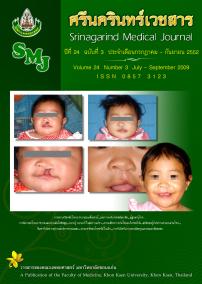ThaiScience
ThaiScience
SRINAGARIND MEDICAL JOURNAL
Volume 36, No. 04, Month JULY, Year 2021, Pages 425 - 430
Health risk level of health workers exposed to ionizing radiation in cardiac catheterization laboratory
Piyapong Sirinapakul, Naesinee Chaiear, Pattarapong Makarawate, Chariya Bamrungsiri, Chamnian Pattanajak, Nikom Namkoch
Abstract Download PDF
Background and Objectives: Ionizing radiation (IR) from fluoroscopy in cardiac catheterization laboratory (cath lab) has health effect on health workers. The health workers in cath lab have higher risk for cataracts than other health works 2-4 times. The as low as reasonably achievable (ALARA) principle is applied among cath lab workers exposed to IR from fluoroscopy; however, an evaluation of the IR risk is needed. The purpose of the current study was to determine the risk of IR from fluoroscopy among cath lab workers. Methods: A descriptive study was conducted. A walkthrough survey was performed during operation of the cath lab. Sixteen workers participated in the study; they were observed by the researcher using a Semi-Quantitative 3x3 Matrix (SQM). The workers were asked to perform a Radio-Protection Questionnaire (RPQ). All data from the SQM, RPQ, and personal radiation dosimeter were analyzed to determine the health risk level. Results: The health risk level of workers assessed vis-à-vis severity and chances of exposure to IR was high. The SQM revealed that the chances of exposure of the 16 workers was moderate. Chance of exposure comprised frequency of exposure, use of lead glasses, optically stimulated luminescence (OSL), and occupational safety training. The RPQ to which 14 of
Keywords
oni zi ng radi ati on; fluoroscopy; catheterization laboratory; risk assessmentSRINAGARIND MEDICAL JOURNAL
Published by : Faculty of Medicine, Khon Kaen University
Contributions welcome at : http://www.smj.ejnal.com/e-journal/journal/index.php
